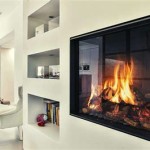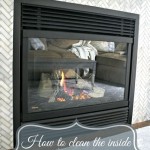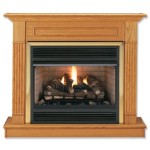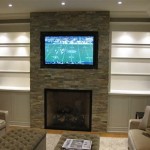Ventless Gas Fireplace Inserts with Blower: A Comprehensive Guide
Ventless gas fireplace inserts with blowers offer a convenient and efficient heating solution for homes. These units, designed to fit within existing fireplace openings, provide supplemental heat without the need for a chimney or venting system. The integration of a blower further enhances their performance, distributing warm air more effectively throughout the room. This article explores the functionality, benefits, considerations, and maintenance aspects of ventless gas fireplace inserts equipped with blowers.
Ventless gas fireplace inserts operate by burning natural gas or propane. The combustion process generates heat, which radiates into the surrounding space. Unlike traditional fireplaces or vented gas inserts, ventless models are designed to burn fuel very efficiently, resulting in minimal emissions. They are equipped with oxygen depletion sensors (ODS) that automatically shut off the unit if oxygen levels in the room become critically low. This safety feature is crucial, ensuring the unit does not pose a carbon monoxide hazard.
The blower component, also known as a fan, significantly improves the heat distribution capabilities of the insert. Without a blower, the heat primarily radiates directly from the unit, creating a localized warm area. The blower forces air over the heated firebox surfaces, warming the air and propelling it into the room. This process effectively circulates the heat, creating a more uniform temperature throughout the space and improving overall heating efficiency.
Understanding the Mechanics of Ventless Gas Fireplace Inserts
A ventless gas fireplace insert comprises several key components that work together to provide heat. The burner, the heart of the unit, is responsible for combusting the gas fuel. Modern burners are designed for optimal efficiency, minimizing unburned fuel and maximizing heat output. The ODS, a critical safety feature, monitors oxygen levels and shuts down the unit if the levels fall below a predetermined threshold. This prevents the build-up of carbon monoxide.
The firebox is the enclosure that houses the burner and is typically constructed of durable materials like steel or cast iron. Its design is optimized to radiate heat effectively. Artificial logs, crafted from ceramic or refractory materials, are placed within the firebox to mimic the appearance of a traditional wood-burning fireplace. The blower, usually positioned beneath or behind the firebox, draws cooler air from the room and forces it through the heated area. The warmed air is then discharged back into the room through vents or louvers.
The control panel provides the user interface for operating the unit. It typically includes a gas valve control to adjust the flame height and heat output, a blower speed control to regulate the airflow, and an ignition system for starting the fire. Some models may also include a thermostat, allowing for automatic temperature control.
Advantages of Ventless Gas Fireplace Inserts with Blowers
Ventless gas fireplace inserts offer several compelling advantages, particularly when equipped with a blower. The primary benefit is the absence of a chimney or venting system. This makes them ideal for homes without existing fireplaces or for homeowners who wish to avoid the cost and complexity of installing a chimney. The ease of installation is a significant factor for many buyers, as it often involves simply connecting the unit to a gas line and plugging it into an electrical outlet.
Enhanced heating efficiency is another key advantage. Ventless gas fireplaces are designed to burn fuel very efficiently, converting a high percentage of the energy into heat. The blower further improves efficiency by distributing the heat evenly throughout the room, reducing temperature stratification and minimizing wasted energy. This combination of efficient combustion and effective heat distribution can lead to significant cost savings on heating bills.
The aesthetic appeal of ventless gas fireplace inserts is also noteworthy. The realistic artificial logs and flame patterns create a visually appealing focal point in the room. Many models offer customizable features, such as adjustable flame height and ember bed lighting, allowing homeowners to tailor the appearance to their preferences. The ambiance created by a gas fireplace can enhance the comfort and enjoyment of a living space.
Operational convenience is another important factor. Ventless gas fireplaces are easy to operate, with simple controls for adjusting the flame and blower. They start quickly and do not require the user to gather wood or clean up ashes. The lack of wood-burning mess and hassle makes them a convenient alternative to traditional fireplaces.
Important Considerations Before Purchasing and Installing
While ventless gas fireplace inserts offer several benefits, there are important considerations that homeowners should address before purchasing and installing a unit. Proper sizing is critical for optimal performance and safety. The size of the unit should be appropriate for the size of the room it is intended to heat. A unit that is too small will struggle to adequately heat the space, while a unit that is too large may cause overheating and discomfort.
Adequate ventilation is essential, even with ventless models. While these units do not require a chimney, they do consume oxygen during combustion. It is crucial to ensure that the room has adequate air circulation to prevent oxygen depletion. Opening a window slightly or using a ceiling fan can help to maintain adequate air quality. Building codes often stipulate minimum room sizes and ventilation requirements for ventless gas fireplaces.
Safety is paramount. It is essential to choose a unit that is certified by a reputable testing agency, such as CSA or UL. These certifications ensure that the unit meets stringent safety standards. Proper installation is also crucial for safe operation. It is recommended that installation be performed by a qualified professional to ensure that the unit is properly connected to the gas line and that all safety features are functioning correctly.
Understanding local building codes is vital before installing any gas appliance. Many jurisdictions have specific regulations regarding the installation of ventless gas fireplaces, including requirements for room size, ventilation, and gas line connections. Failure to comply with these codes can result in fines or the need to remove the unit.
Potential drawbacks also exist and should be carefully considered. Ventless gas fireplaces do produce some emissions, including water vapor and small amounts of nitrogen dioxide. These emissions can potentially contribute to indoor air pollution, particularly in poorly ventilated spaces. Some individuals may be sensitive to these emissions, experiencing respiratory irritation or other health problems.
The odor associated with ventless gas fireplaces is another potential concern. Some units may produce a noticeable odor, especially when first turned on or after prolonged use. This odor is typically caused by the combustion of small amounts of impurities in the gas. While the odor is generally not harmful, it can be unpleasant for some individuals. Regular cleaning and maintenance can help to minimize odor issues.
Maintenance and Safety Procedures
Regular maintenance is essential for ensuring the safe and efficient operation of a ventless gas fireplace insert. One of the most important maintenance tasks is cleaning the burner and the area around the logs. Over time, dust, debris, and soot can accumulate on these components, potentially affecting the burner's performance and increasing the risk of carbon monoxide production.
The oxygen depletion sensor (ODS) should be inspected regularly to ensure that it is functioning properly. This sensor is a critical safety feature that prevents carbon monoxide poisoning. If the ODS is not working correctly, the unit should be shut off immediately and repaired by a qualified technician. Testing the ODS typically involves observing the flame characteristics and ensuring that the unit shuts down when the oxygen supply is restricted.
The blower should also be cleaned periodically to remove dust and debris. A buildup of dust on the blower motor can reduce its efficiency and potentially cause it to overheat. Cleaning the blower typically involves using a vacuum cleaner or compressed air to remove dust from the blower blades and motor housing.
It is also important to inspect the gas line connections for leaks. Gas leaks can pose a serious fire hazard. Using a soapy water solution to check for leaks around the gas line connections is a simple but effective method. If any leaks are detected, the gas supply should be shut off immediately, and a qualified technician should be called to repair the leak.
Carbon monoxide detectors should be installed in the room where the ventless gas fireplace is located. Carbon monoxide is a colorless, odorless, and deadly gas. A carbon monoxide detector provides an early warning of dangerous levels of carbon monoxide in the air. Detectors should be placed according to the manufacturer's instructions and tested regularly to ensure they are functioning correctly. Replacing the batteries in the carbon monoxide detector regularly is crucial for maintaining its effectiveness.

Duluth Forge 27 625 In W 32000 Btu Black Vent Free Dual Burner Gas Fireplace Insert The Inserts Department At Com
:max_bytes(150000):strip_icc()/ventless-gas-fireplaces-4160746-hero-f9d4bdcd9bd446eb84406de306f790ba.jpg?strip=all)
How To Pick Out A Ventless Gas Fireplace

Vent Free Inserts White Mountain Hearth

Duluth Forge 36 In Ventless Dual Fuel Fireplace Insert With Remote Control Fdi32r The Home Depot

Pleasant Hearth Universal Circulating Zero Clearance 32 In Ventless Dual Fuel Fireplace Insert Phzc32c The Home Depot

30 Ruby Contemporary Intellifire Touch Direct Vent Fireplace Insert Blower And Remote Electronic Ignition Majestic

35 Ruby Traditional Intellifire Touch Direct Vent Fireplace Insert Blower And Remote Electronic Ignition Majestic

Duluth Forge 34 In W 32000 Btu Black Vent Free Dual Burner Gas Fireplace Insert And Remote The Inserts Department At Com

Procom Universal Ventless Firebox 170016 The Home Depot

White Mountain Hearth By Empire Ventless Outdoor Traditional Premium Gas Fireplace 36








